Scenario 1: It’s Friday night, and Kiran decides to order some burger, fries, and a bottle of soft drink to go with it. He finishes drinking the beverage and puts the bottle in the recycle bag, with all his other dry waste, and places the bag out, on the day BBMP workers pick up recyclables.
Scenario 2: Anita is hosting a birthday party, and she orders soft drinks, along with other snacks and beverages.. Post the party all the bottles go into the recycle bag that is placed outside her apartment door.
Scenario 3: Jayamma, is a pourakarmika, in Ward 171. She is in charge of cleaning 6th Avenue, and finds some soft drink bottles on the street.
So what happens to the soft drink bottles in these scenarios?
When I started working with waste pickers in the early 90s, landfills were filled with PET bottles, there were no takers, no recycling of PET was possible. Today this is the most sorted material, as it can be recycled to PET, down cycled to fabric etc. It provides livelihood for informal waste workers across the supply chain.
Nalini Shekar, Co-founder, Hasiru Dala
Read more: How to manage COVID waste in apartments and gated communities
Segregation and processing of recyclables
Items put into the recycling bag, go through many different steps in the entire recycling value chain. Let’s follow different loads of recycling along the recycling journey.
Step 1: From your home to the tempo to the DWCC
If you live in an apartment, the housekeeping staff collect these bottles along with the rest of your dry waste. They take it down to the collection area, where your apartment’s service provider picks it up and takes it to their facility where all the dry waste is further segregated.

If you live in an independent house, the team from the local Dry Waste Collection Centre (DWCC) is tasked to collect all dry waste from individual houses, based on the ward micro plan and takes it to the dry waste collection centre, where it is further segregated depending on the type of material – paper, plastic, glass, or metal.
Pourakarmikas like Jayamma and waste pickers may also pick up bottles during the course of their work, and sell them at the local neighbourhood scrap dealer or dry waste collection center.
In Bengaluru, the recycling value chain is complex and networked, intersecting and interconnecting at various levels — the formal collection including dry waste collected at street sweeping levels, hybrid collections like the dry waste collection centers and the informal waste collection – waste pickers, itinerant buyers, local scrap dealers — often converging at the recycling trading markets like Jolly Mohalla or the recycling hubs like Nayandahalli, Kumbalgodu, etc.
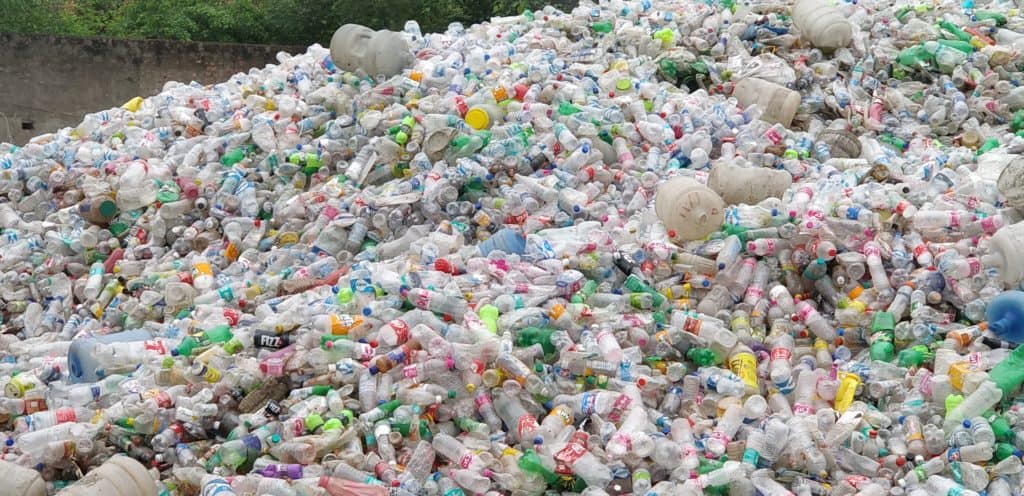
In each of the three scenarios, the dry waste collection bags are first weighed and then the entire content is emptied out on the sorting floor at the DWCC.
The waste sorters at each of these facilities normally collate all the bigger items like paper and cardboard for further segregation.
The sorters are forced to sift out items such as gloves, masks, sanitary pads, diapers, footwear, cloth, etc that make their way into the collection center. Furthermore, leftover food in half-empty bread packets, half-eaten chips bags, bottles with water or beverages, take away containers with food inside etc., which are wrongly discarded in the dry waste bin, get removed.
Read more: What does it mean to live near a solid waste dump yard in our cities?
Step 2: From the DWCC to the aggregation centre
Once all the soft drink and mineral water bottles are collected, the question arises what happens to these bottles? Soft drink/mineral water bottles are made of Polyethylene terephthalate (PET), one of the most widely used plastics today.
At the DWCC, PET bottles are further segregated, based on colour and type, and it then makes its way to an aggregation centre in Jolly Mohalla (near KR Market) or Nayandahalli (adjacent to Mysore Road). Water and soft drink bottles are not mixed with other PET containers as they have a separate recycling stream.

How is paper processed?
From the DWCC, each paper-based item is then bailed, tied and stacked up for further trading or processing. From the aggregators, paper makes its way to either factories near Jigani, Doddaballapur, or to Coimbatore and Hyderabad. Newspaper stacks are sent to very large aggregators in Jolly Mohalla, or Hosur Road and then transported to paper mills in Coimbatore, Sivakasi etc.


At Bengaluru, in some of the aggregation centres, the labels and caps of water and soft drink bottles are not removed before baling, as the traders then transport it to the recyclers based in Gujarat, Delhi, or Mumbai.
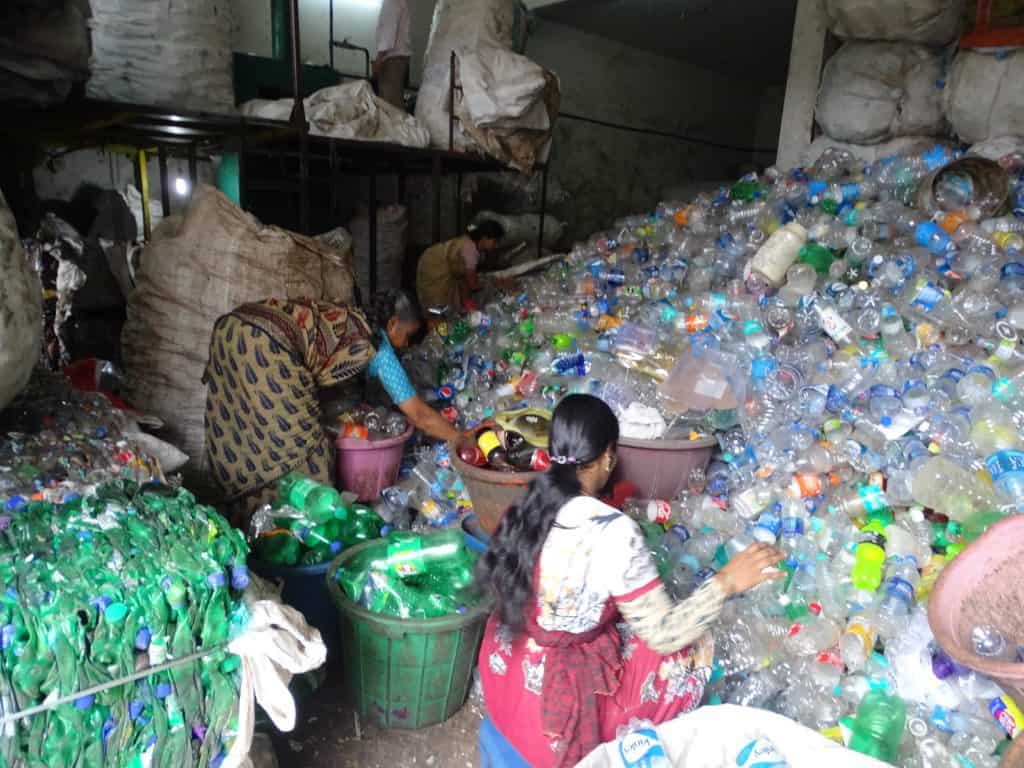
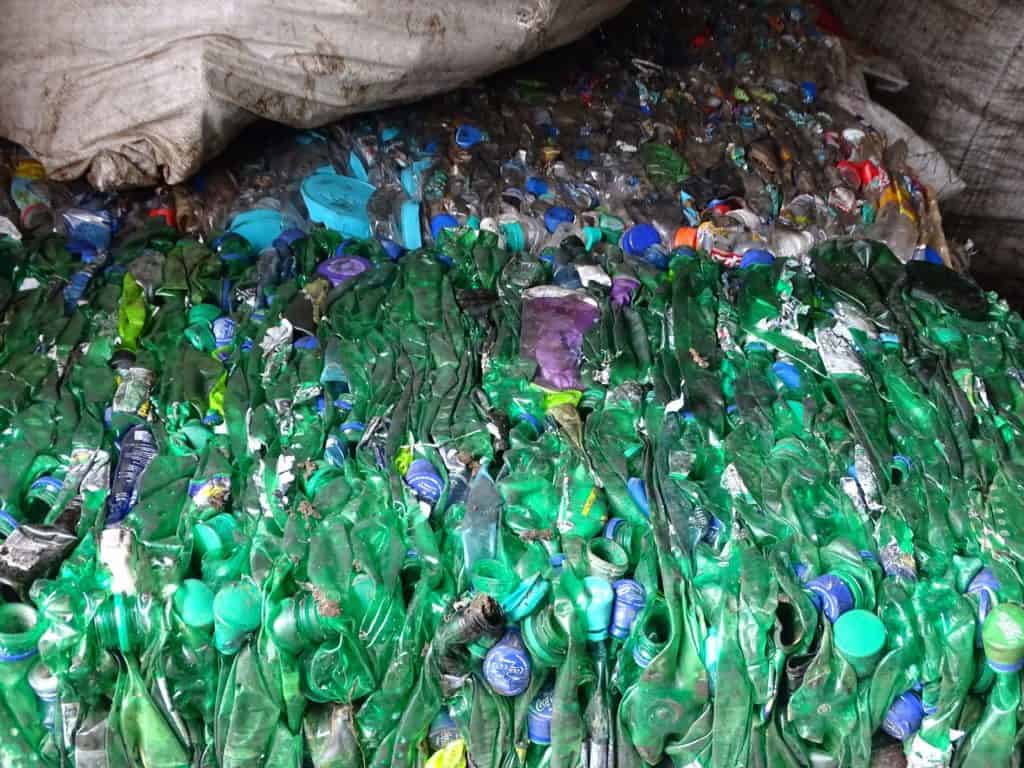
In some of the other facilities, like the Hasiru Dala Innovations Private Limited’s Aggregation Centre, they aggregate PET plastic waste from DWCCs, waste picker entrepreneurs, and scrap dealers. The aggregated PET waste is then further segregated into clear PET, green, brown, liquor bottles, pharma bottles, etc. as recyclers need raw material inputs in as homogenous a manner as possible. For one end user FMCG brand, they remove labels from the clear PET bottles and its final destination is a European recycler who makes into food-grade PET pellets to be mixed with virgin PET to make new bottles.
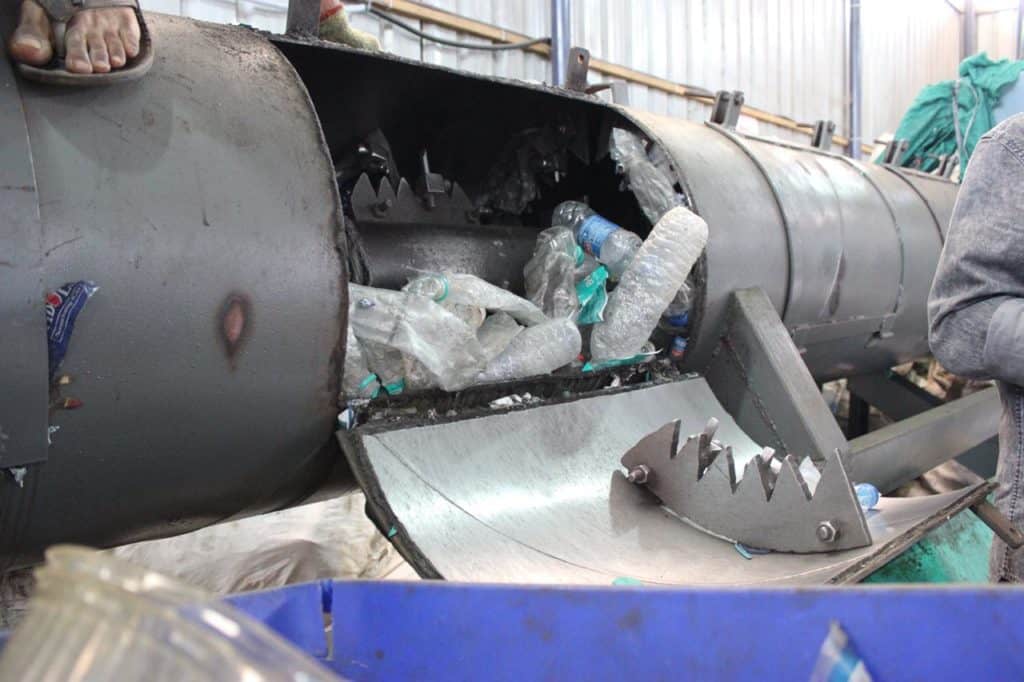
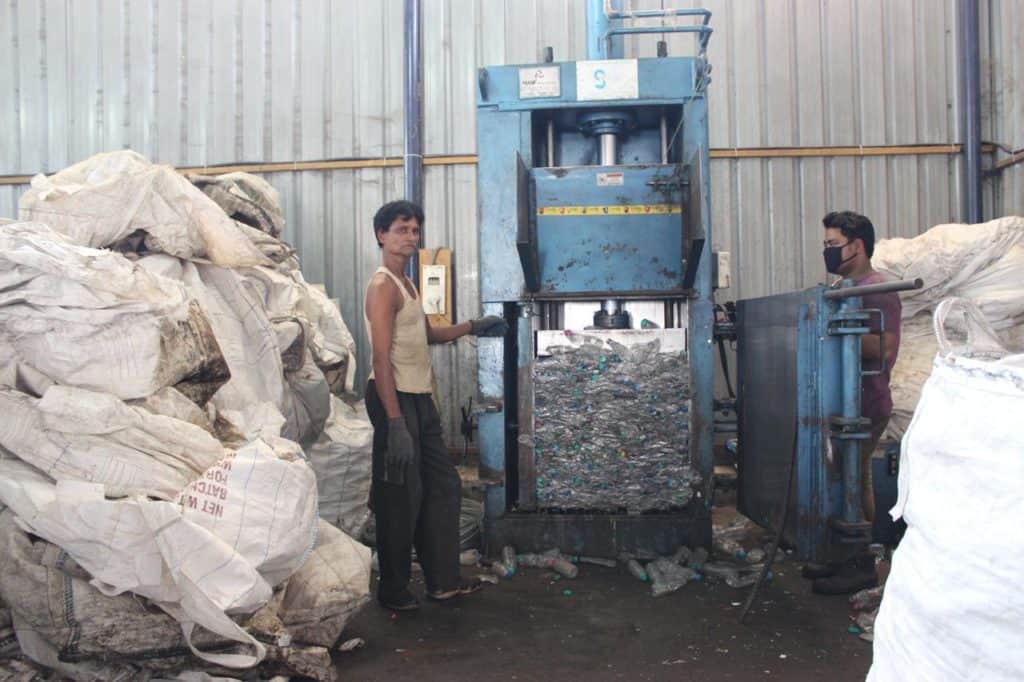
In Delhi, the recyclers remove all the non-PET components like caps, neck rings, and labels before baling it based on type, and they are then shredded, washed, and further sold as washed flakes. The washed flakes are mostly used to make polyester fiber. This material is used as filling material for cushions, pillows, or converted to fabrics for clothing, upholstery, etc.
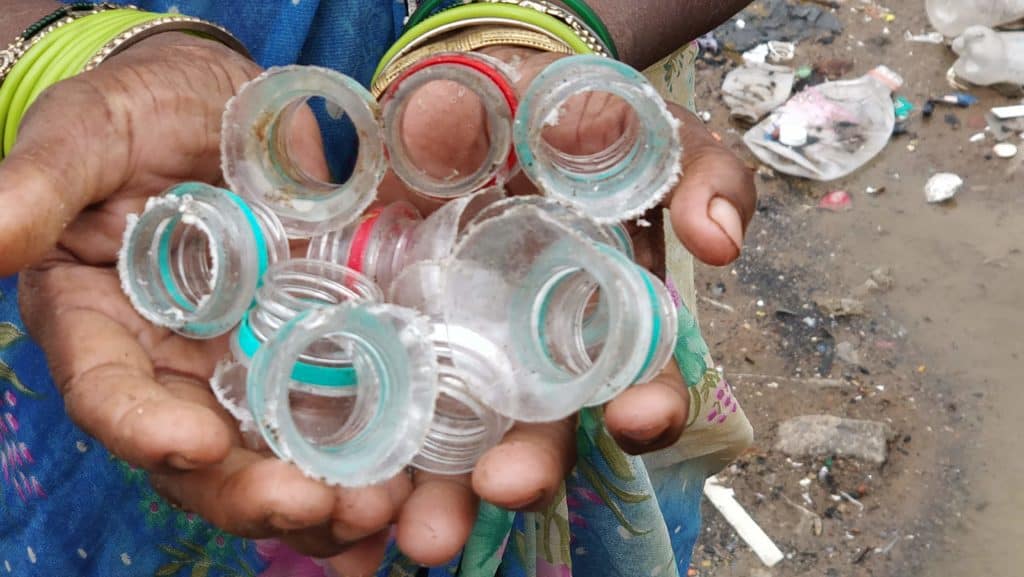
How are recyclables segregated?
Plastics
Plastic waste is separated into a number of categories, like:
- LD White – White smooth plastic (Milky finish) used to wrap consumer durable items;
- LD Colour – Smooth colour plastics (Blue, green etc) used as packaging material;
- HM (white) Typical plastic bags with or without handle – grocery, hardware, retail shops;
- HM (Colour)- Typical plastic bags with or without handle – grocery, hardware, retail shops;
- HDPE – Hard plastics used to pack liquids, household cleaners, detergents, shampoos, water /juice jugs etc;
- PP (white)- Hard white plastics – food containers;
- PP (Colour) Typically given out in cloth stores, plastic woven gunny bags;
- PP (Black)- Garbage bags;
- Coating PP (called Kurkure colloquially) – Multilayered low value plastic items such as savoury, chips packet, biscuit packets etc;
- Phugga (white)- Food parcel containers, buckets, mugs;
- Phugga (colour) -Coloured buckets, mugs; PVC- Pipes, transparent files, plastic sheaths; Super- Low quality, soiled plastics;
- LLDPE or Milk Covers; Tooth Brush; Palm Oil covers Road waste;
- PET- Water bottles, medicine/chemical bottles, aerated drinks/juice bottles/oil containers;
- EPS – Foam products (Thermocol, Styrofoam) – Only soft foam is collected, aggregated and processed.
Source: Valuing Urban Waste: The need for a comprehensive recycling policy in India; Hasiru Dala 2018.
Glass
Glass Bottles are segregated based on type – beer bottles – white, green, brown; Other liquor bottles; glass bottles such as ketchup, pickles, coffee and other malted drinks such as Horlicks; broken glass bottles; and broken glass tumblers, plates, and window panes, etc. Unbroken glasses are traded by piece and broken glass are traded by weight.
Paper
All paper-based items are further segregated into newspaper, carton, corrugated – cardboard boxes, notebooks, textbooks, white paper, coloured paper, glossy paper, shredded paper, magazines, tissue paper etc. In this segment, some recyclers also segregate paper cups and tetrapak.
Metal
Metal is categorized into scrap iron, aluminium, copper, tin, brass, and bronze.
What happens to your dry waste?
What if your trash could talk?
From the worn-out sneakers that ran marathons,
To the tubes that encased lavender-infused body wash,
From the empty bottles of alcohol that tell tales of midnight woes,
To the printer, that wouldn’t print love stories anymore,
From the strings that could not tie,
To the mirror that broke hearts,
From the clock that could not heal,
To the chocolate wrappers that aided sinful pursuits,
But what about your mattress, your favourite dress, the special toy?
Does one ever pause to wonder
Of the journey of your trash?
Pinky Chandran, 2017
Pinky chandan good article
Great information. I read somewhere that newspaper waste which must be one of the heaviest, can only be reused for drying out fabric that is manufactured in textile mills. Is this true? It can’t even be made into cardboard because of the newsprint is what I understood.